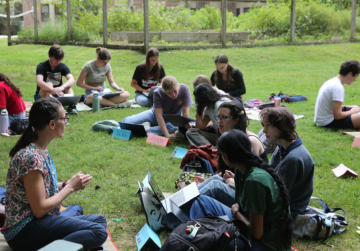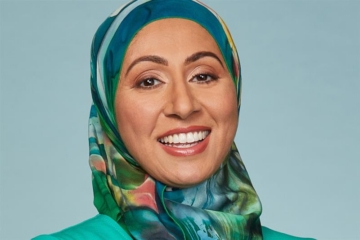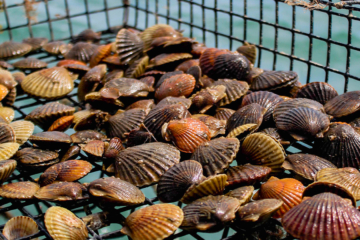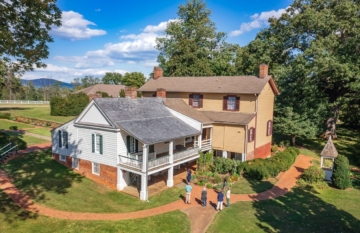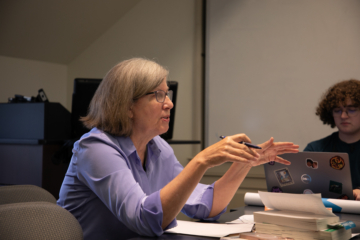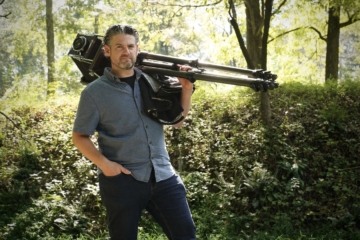Ibes leads Sharpe Scholars outdoors, into communities
The following story originally appeared on the website for the Charles Center. – Ed.
The Sharpe Community Scholars program embodies commitment to community – in fact, it’s in the name.
Now celebrating its 25th anniversary, the first-year living-learning community continues to serve as a national model for undergraduate collaborative research and community engagement across a variety of methods and fields.
According to Monica Griffin, Sharpe’s director, the program has helped foster a range of undergraduate research opportunities centered on the environment and issues of environmental justice over the last quarter century.
Among the many community-focused learning opportunities for Sharpe Scholars is ENSP 100, “Big Ideas in Environmental Science: Mapping Community Nature Rx,” led by Dorothy Ibes, teaching professor in William & Mary’s Environment & Sustainability Program (ENSP).
Now in its third year, ENSP 100 takes on the idea and practice of “learning outside the classroom, as something that can be made accessible to all residents of a community for the greater good,” said Griffin.
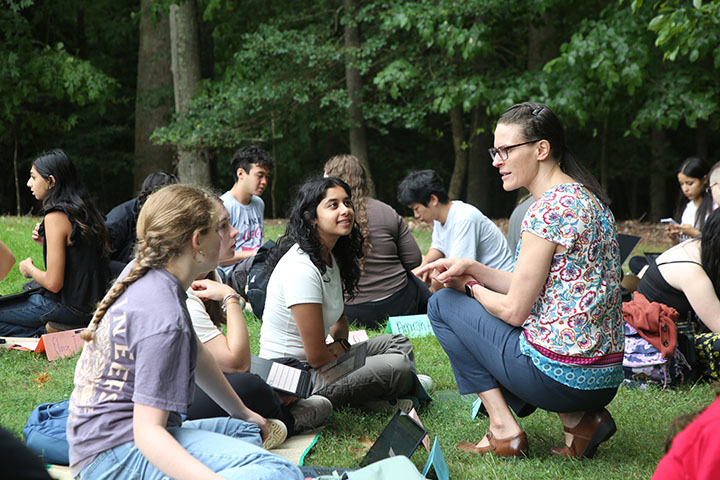
Ibes, founding director of the Parks & Ecotherapy Research Lab (PERL), describes her course as “a buffet of different topics,” blending communication design, urban planning, parks, ecotherapy, geographic information systems (GIS), environmental justice and human-environment geography.
“My interest and experience in ecotherapy, and nature, and health research and then GIS — I taught intro GIS for seven or eight years here — I incorporated all of this into this course,” Ibes said. “With a real focus on increasing accessibility of these places, addressing as many of those barriers to nature engagement as possible.”
Working within communities
There are two sections of the course: one open to all students, the other limited to Sharpe Community Scholars. In both, students are assigned to a local greenspace and work in teams to create an interactive, public-facing ArcGIS StoryMap — a multimedia webpage designed to help the broader community engage with that park or natural area.
Students begin by conducting secondary research, followed by fieldwork to collect data in person. That part, says Ibes, is essential.
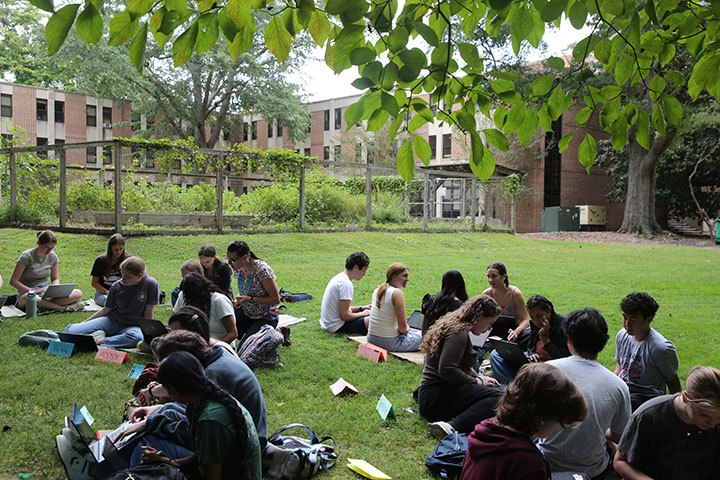
“I want them to actually physically get into the park,” she explained. “I want them to notice the difference between seeing it online and going to see it — it’s a totally different experience. I want them to think about: How do I help other people have an amazing experience here, especially people who don’t normally go to these spaces?”
The community-based methodologies and research fostered by Ibes embody the mission of the Sharpe Scholars program, according to Griffin. “We’re encouraging students to work with and within communities, which is different than studying communities,” she said.
Some of these StoryMaps have even made their way into broader circulation.
“York River State Park has used one of our StoryMaps for their park, and they love it — as a way of communicating what their park has, and its features and supporting visitors in a different way,” Ibes said.
The empirical skills students walk away with — science communication, research tactics, GIS mapping — are widely applicable. But Ibes hopes they also leave with something deeper.
“I want the product of the class, and the knowledge of the class to be very practical beyond the course, and applicable to as many different contexts as possible,” she said. “And also, I really try to embed that deep kind of sense of the importance of engaging with nature and helping others do so as well.”
A career rooted in nature
Ibes is also one of the founders of the Campus Rx movement, a national coalition of colleges and universities working to improve student mental health through nature engagement, research and outreach. The initiative took shape over a decade ago, when co-founder Don Rakow contacted Ibes after learning about her work with the PERL.
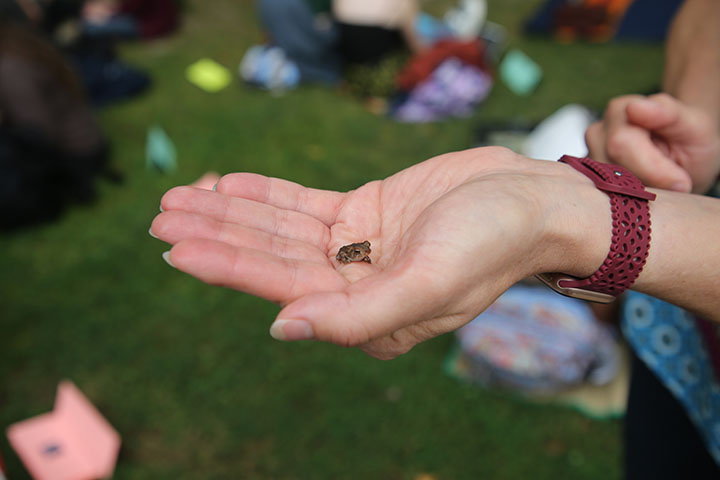
Today, the PERL conducts several ongoing research projects, from revamping the campus bird space map to partnering with the Association of Nature and Forest Therapy. Eleven students currently work in the lab — many of them alumni of ENSP 100 or Ibes’ ecotherapy courses.
Ibes’ passion for accessibility is grounded in research. Alongside Rakow, she led a three-year study exploring the barriers youth face in accessing nature. They found three overarching categories: psychological barriers, physical/external barriers and land development barriers — and identified 14 subcategories within them.
“It’s complicated. In short, it’s very complicated,” Ibes said. “It’s more than just everybody prefers to be on their phone or on social media. That is a thing, but also, if we had all these other supports, would people spend more time outside? Probably.”
Making nature accessible
That time outdoors, she emphasizes, is vital to health.
“There’s actually decades and decades of really solid research, showing a very clear connection between nature engagement and health — mental health, physical health, resilience, creativity, cognitive function, social health, social capital … I mean you name it,” she said. “Time in a safe, comfortable place in nature is going to help that.”
She’s seen the effects firsthand, especially when holding class outdoors.
“The difference from the beginning to the end of a 50-minute class even, just to have it outside — it’s night and day,” she said. “If more professors really experienced it, they would be much more motivated to have class outside, even if it’s once a semester or once a month.”
Ibes’ students have grasped this importance of the outdoors. Sharpe Scholar and ENSP and philosophy major Elijah Clark ’28, after taking ENSP 100 his freshman year, was inspired to continue his work in outdoor-focused community engagement. He joined PERL and became co-leader and then leader of the Outdoor Classrooms Project — an initiative focused on implementing outdoor space into learning curriculums here on campus.
Clark noted how influential Ibes’ class and guidance have been.
“Professor Ibes is incredibly talented and incredibly passionate about making people’s lives better through her work,” he said. “She’s been incredibly supportive of my outreach to other environment internships and opportunities, and I cannot wait to work with her the rest of my time here at W&M.”
A simple message: Go outside
At the heart of Ibes’ work is a belief that connection with nature is essential — and too often lost.
“My main goal with my entire career, and my classes, and my research, is really to help people build, or rebuild, or strengthen, or foster their relationship with nature,” she said. “Because so many of us are very disconnected from it.”
Her advice is simple. “You can go out there and play right now, just like you did when you were eight,” Ibes said. “You can get dirty. You can be in the rain. Maybe you want to not do it in between classes — that’s fine. But you could do it. You can.”
“And the importance of play as an adult — for creativity, for stress release, for social bonding — is huge.”
Through efforts like Clark’s and others in Sharpe, program director Griffin says, the future of community-based environmental engagement at W&M feels both hopeful and grounded. “Under the guidance of committed faculty like Ibes, students’ research reminds us that meaningful change often begins with a simple step outside.”
Latest W&M News
- Award-winning journalist Asma Khalid to deliver fall 2025 Atwater LectureKhalid will deliver Alma Mater Production’s Fall 2025 Atwater Lecture on Oct. 14 at Sadler Center’s Commonwealth Auditorium.
- ‘Here Comes the Sun’: Tack Faculty Lecture to explore the science of building a star on EarthPhysics Professor Saskia Mordijck will present the fall 2025 Tack Faculty Lecture, “Here Comes the Sun: Building a Star on Earth.”
- Bay scallops surge on the Eastern ShoreOnce locally extinct, the Virginia bay scallop population is increasing exponentially due to restoration work by W&M’s Batten School & VIMS Eastern Shore Laboratory.
- Highland celebrates 50 years of W&M stewardship, aims to expand its scholarly impactIn honor of the anniversary, Highland is conducting a lecture series highlighting its recent high-impact projects and the many perspectives that have shaped them.
- Holladay named inaugural Sharp Writer-in-ResidenceHilary Holladay M.A. '87 is the Charles Center’s inaugural Sharp Writer-in-Residence.
- Library of Congress collects photographic work of W&M professorTwenty photographs created by William & Mary Professor Eliot Dudik have been acquired by the Library of Congress for its permanent collection.



